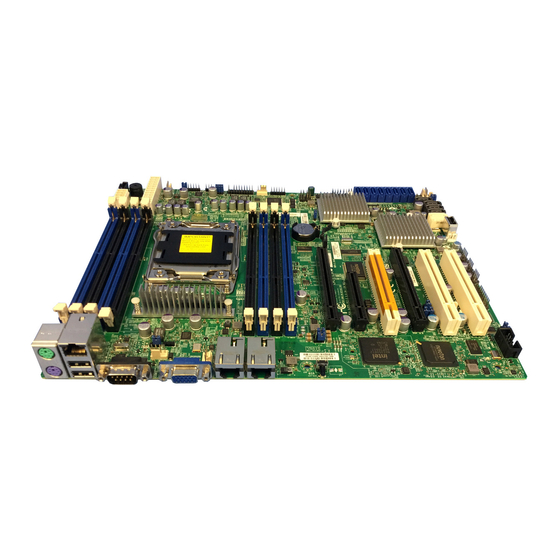
Table of Contents
Advertisement
Advertisement
Table of Contents

Summarization of Contents
Introduction and Motherboard Overview
1-1 Overview: Checklist and Support Resources
Details the contents of the motherboard retail box and provides support links for drivers and manuals.
Motherboard Layout and Key Components
Illustrates the physical layout of the motherboard, highlighting connection points, jumpers, and headers.
Motherboard Features and Specifications
Lists and describes the key hardware features and specifications of the X9SRH motherboard series.
Chipset Overview: Intel C602J Features
Explains the capabilities and features of the Intel C602J chipset used on the motherboard.
Special Features: AC Power Loss & ACPI
Covers special motherboard features like AC power loss recovery and ACPI power management capabilities.
PC Health Monitoring: Temperature, Voltage, Fan Control
Describes the system's ability to monitor CPU temperature, voltages, and fan speeds via onboard sensors.
Power Supply Requirements and Connections
Specifies the necessary power supply and connector requirements for the motherboard and system stability.
Super I/O and Management Controller Overview
Details the Super I/O chip and the Nuvoton WPCM450 Baseboard Management Controller functions.
Hardware Installation Procedures
2-1 Static-Sensitive Device Handling Precautions
Outlines essential precautions for handling static-sensitive components to prevent damage during installation.
2-2 Processor and Heatsink Installation: LGA2011 Socket
Provides step-by-step instructions for installing the CPU and heatsink, including socket details.
Installing DDR3 Memory Modules: DIMM Procedures
Guides users on how to correctly install and remove DDR3 memory modules into the DIMM slots.
2-4 Motherboard Installation: Chassis Mounting Guide
Explains the process of physically mounting the motherboard into the computer chassis, including tools needed.
2-5 Connectors and I/O Ports: Backpanel and Headers
Identifies and describes the various connectors, ports, and headers on the motherboard's I/O panel and internal headers.
2-6 Connecting Cables: Power, Fans, and Optional Devices
Details how to connect power cables, fan headers, and other optional devices to the motherboard connectors.
2-7 Jumper Settings: System Configuration Options
Explains the function and configuration of various jumpers on the motherboard for system control and feature enabling/disabling.
2-8 Onboard Indicators: LEDs for System Status
Describes the function of onboard LEDs and indicators used for system status, network activity, and power.
2-9 SATA and SAS Storage Connections
Details the SATA and SAS connectors on the motherboard and their pin definitions for storage devices.
Troubleshooting and Technical Support
3-1 Troubleshooting Procedures: Startup and Hardware Issues
Provides systematic procedures to diagnose and resolve common system startup problems like no power or no video.
Memory Errors and Setup Configuration Troubleshooting
Addresses troubleshooting steps for memory errors and issues related to losing system setup configuration.
3-2 Technical Support Procedures and Contact Info
Outlines the steps to take before contacting technical support and provides relevant contact information and resources.
3-3 Frequently Asked Questions (FAQ)
Answers common questions regarding memory support, BIOS updates, and driver installation procedures.
3-4 Battery Removal and Installation: Safety Guide
Explains the safe procedure for removing and installing the motherboard battery, including disposal warnings.
3-5 Returning Merchandise for Service: Warranty Process
Details the process for returning products for warranty service, including RMA procedures and warranty coverage information.
BIOS Configuration and Settings
4-1 Introduction to AMI BIOS Setup Utility
Introduces the AMI BIOS Setup Utility and how to navigate its screens and basic functions.
How to Start the BIOS Setup Utility
Guides the user on how to access the BIOS setup utility during system boot.
4-2 Main Setup: System Information Display
Covers the main BIOS setup screen, displaying system overview information like date, time, and memory.
4-3 Advanced Setup: Boot Features and CPU Settings
Details advanced BIOS settings related to boot features, CPU configuration, and power management.
Chipset, DIMM, and Memory Configuration Options
Explains settings for chipset features, memory configuration, and various performance-tuning options.
South Bridge, SATA, PCIe, and USB Settings
Covers settings for south bridge features, SATA modes, and PCIe slot configurations.
4-4 Event Logs and SmBIOS Management
Explains how to manage system event logs and configure SmBIOS logging features for system diagnostics.
4-5 IPMI Configuration: System Logs and Network
Details Intelligent Platform Management Interface (IPMI) settings for system monitoring and management.
4-6 Boot Settings: Device Priority and Boot Options
Guides users on configuring boot device priority, boot options, and security settings.
4-7 Security Settings: Password Management
Covers BIOS security features, including password protection and access control settings.
4-8 Save & Exit: Managing BIOS Configuration
Describes how to save, discard, or restore BIOS settings, and exit the setup utility.
Appendices and Software Information
Appendix A: BIOS Error Beep Codes
Lists BIOS beep codes and their corresponding error messages for diagnosing POST failures.
Appendix B: Software Installation: Drivers and Utilities
Provides guidance on installing drivers and software utilities included with the motherboard, such as SuperDoctor III.
Appendix C: UEFI BIOS Recovery Guide
Explains how to recover the UEFI BIOS image using a USB-attached device in case of corruption.













Need help?
Do you have a question about the Supero X9SRH-7TF and is the answer not in the manual?
Questions and answers